3.08.2023
ESA still seems shy about sharing news on Ariane 6 rocket testing
Officials don't plan to broadcast a key Ariane 6 test-firing on its launch pad.

Last month, a full-scale test model of Europe's Ariane 6 was put to the test on its launch pad in the jungles of French Guiana. For the first time, the launch team at the tropical spaceport loaded cryogenic liquid hydrogen and liquid oxygen into the Ariane 6 over the course of a marathon 26-hour test campaign.
But it took a week for the European Space Agency, which is funding the 3.8 billion euro ($4.1 billion) development of Ariane 6, to release an update on the test. It turned out the launch team could not accomplish one of the main goals of the countdown rehearsal: A brief four-second ignition of the Ariane 6's main engine.
An ESA spokesperson described the test on July 18 as "very satisfactory" even though the engine didn't light. It's true that the simulated countdown checked off some key objectives. The launch team in French Guiana—consisting of membership from ESA, prime contractor ArianeGroup, and the French space agency CNES—supervised the loading of more than a half-million liters of liquid hydrogen and liquid oxygen into the 207-foot-tall (63-meter) Ariane 6.
"During the 26-hour exercise, the teams successfully tested many degraded and contingency modes, demonstrating that the launcher and the launch base fit correctly," ESA said. "Operational procedures, lower and upper stages, avionics, software, launch base, and control bench worked correctly together, and the performance of the full launch system was measured with excellent results."
The countdown test on July 18 proceeded up to the time that the Ariane 6's Vulcain 2.1 main engine would have ignited during a real launch attempt. Going into the test, officials planned to fire the engine for approximately four seconds while the Ariane 6 remained on the pad. Managers called off that objective because time ran out, ESA said, without offering additional detail.
The Ariane 6 countdown test originally started July 13, but the countdown that day was cut short before the test continued five days later. ESA didn't mention that in its press release discussing the outcome of the countdown rehearsal.
You won’t get to watch the Ariane 6 hot-fire test
An ESA spokesperson told Ars that engineers are considering whether to mount another countdown rehearsal to complete the four-second engine-firing milestone or to go directly to a follow-up simulated countdown that was already planned for September. That one will culminate in a longer Vulcain 2.1 engine firing that could last up to 500 seconds, approximating the duration of a main engine burn during launch.
The space agency's spokesperson said ESA is not planning to provide live video of the long-duration Ariane 6 test-firing in French Guiana. That's disappointing and would be a missed opportunity for ESA to engage with the taxpayers footing the bill for this new rocket.
Other entities like ArianeGroup and the French space agency occupy the launch control center consoles for the Ariane 6 testing. ESA not only controls the purse strings but also has the final say in releasing updates on the Ariane 6 program.
ESA's decision not to broadcast live video of the Ariane 6 hold-down test-firing easily contrasts with NASA, which provided live coverage of two hot-fire tests for its Space Launch System rocket in 2021. Like the Ariane 6, NASA's SLS Moon rocket is a publicly funded venture.
Other companies also have livestreamed test firings of their high-profile rockets. SpaceX provided live video of a multi-engine test-firing of its Super Heavy booster earlier this year before it launched on SpaceX's first full-size Starship test flight. In June, United Launch Alliance produced a live webcast for a six-second engine firing of its new Vulcan rocket.
Josef Aschbacher, ESA's director general, has promised more "openness and transparency" from the space agency. After several reporters recently voiced concerns about ESA's opacity, Aschbacher outlined several steps in this area, including more access to ESA officials for journalists and the public release of more ESA documents. Another way ESA could fulfill Aschbacher's pledge is to be more forthcoming with detailed and timely updates on Ariane 6, the agency's most expensive program.
Aschbacher has prioritized modernizing ESA, which draws upon funding from 22 European members. Some of his proposals include a more commercially focused procurement framework, allowing Europe's private sector to move faster than ESA's sluggish bureaucracy. France, Germany, and to a lesser extent, Italy drive Europe's government-funded launch vehicle programs.
But getting all of ESA's member states to buy in to high-level reforms is not easy. Parochial politics are at play, with each nation desiring "geographic return"—i.e., jobs—commensurate with their investment. By definition, that approach limits flexibility and agility in developing a new rocket.
Approving a livestream of the Ariane 6's upcoming engine hot-fire test should be an easier lift. After all, ESA already regularly hosts live launch broadcasts from French Guiana.
These are important times for the Ariane 6 program, which initially targeted an inaugural test launch in 2020. The debut of Ariane 6 is now expected sometime next year—four years late—but ESA has declined to offer a more specific timetable until more test results give the agency some confidence in the schedule.
Aside from the launch pad tests in French Guiana, engineers in Germany plan a pair of firing tests of the Ariane 6's restartable upper-stage engine later this year. By the end of 2023, ESA hopes to disassemble the Ariane 6 test vehicle currently undergoing testing in French Guiana, then install the Ariane 6 assigned for the first flight.
The Ariane 6 delays have left Europe largely without independent access to space, causing ESA to move some of its payloads to launch with SpaceX, a rival to the Ariane rocket on the global marketplace.
The final European Ariane 5 rocket launched on July 5. ESA originally wanted at least a couple of years with both Ariane 5 and Ariane 6 flying. With Ariane 5 now retired, there's even more pressure for ESA and ArianeGroup (the parent company of French launch services company Arianespace) to get Ariane 6 flying as soon as possible.
They need to get it right. A launch failure early in the Ariane 6 program would set back Europe's launch efforts even more. Once operational, ESA will hand over the Ariane 6 to Arianespace for commercial exploitation.
That's not to mention burning questions about the competitiveness of Ariane 6 on the international commercial launch market dominated by SpaceX's partially reusable Falcon 9 rocket. A number of other reusable launchers are on the horizon, but Ariane 6 is based on a single-use expendable design. That puts Ariane 6 at a disadvantage against international competitors and has led Aschbacher to write that Europe is in an "acute launcher crisis."
Speaking in June at the Paris Air Show, ESA's Toni-Tolker Nielsen said the Ariane 6 is projected to come in at higher costs per launch than first predicted. The Ariane 6's cost per flight will be about 40 percent lower than that of the now-retired Ariane 5, short of the goal of a 50 percent cost reduction, Nielsen said.
Quelle: arsTechnica
----
Update: 31.08.2023
.
ESA postpones Ariane 6 hot-fire test again

An Ariane 6 on the pad in French Guiana for a series of hot-fire tests that have been delayed by technical issues. Credit: ESA/CNES/Arianespace/Optique video du CSG/S Martin
WASHINGTON — The European Space Agency says a test-firing of an Ariane 6 core stage has been postponed again, this time because of issues with ground equipment.
In an Aug. 30 update, ESA said that a planned Aug. 29 firing of the core stage of an Ariane 6 on the pad at the spaceport in Kourou, French Guiana, was postponed because of what the agency described as a “technical issue affecting the control bench” that handles propellant loading and the automated countdown.
That test, which will fire the Vulcain 2.1 engine for several seconds, has been rescheduled for Sept. 5. A longer test firing remains planned for Sept. 26, also at the spaceport.
That short-duration test was previously planned for July, but postponed when time allocated for the test ran out. ESA later explained that the automated countdown was aborted “due to certain measurements exceeding preset limits.” The agency delayed the test to late August to give teams a two-week summer break and to perform repairs to a basin used for burning off excess hydrogen that was damaged by water.
A separate test of the rocket’s upper-stage engine remains scheduled for as soon as Sept. 1 at a facility in Lampoldshausen, Germany. That test was postponed from late July because of software issues.
ESA is also moving ahead with a media briefing on Sept. 4 to update those testing efforts and other preparations for the long-delayed first launch of the Ariane 6. ESA acknowledged earlier in the month that the inaugural launch had slipped to some time in 2024, but has not provided a more specific date.
Quelle: SN
----
Update: 5.09.2023
.
Ariane 6 joint update report, 4 September 2023
The Ariane 6 Launcher Task Force consists of top management at ESA, the overall Ariane 6 procuring entity and launch system architect, launch base prime contractor and French space agency CNES, launcher system prime contractor ArianeGroup and launch service provider Arianespace. This group reports regularly on progress being made towards inaugural flight of the new Ariane 6 launcher.
The next update is expected in October.
Key milestones towards inaugural flight:
18 July 2023: Combined tests, hot firing test of the main stage with Vulcain 2.1 engine ignition - At Europe’s Spaceport in Kourou, French Guiana, engineers from ArianeGroup, CNES and ESA, successfully completed for the first time a launcher preparation and countdown sequence.
The 26-hour test included the removal of the mobile gantry, the chill-down of ground and launcher fluidic systems, the filling of the upper and core stage tanks with liquid hydrogen (–253°C) and liquid oxygen (–183°C), and the successful completion of a launch chronology up to the ignition of the Vulcain 2.1 engine thrust chamber by the ground system.
During the exercise fully representative of a launch chronology, the teams successfully tested many degraded and contingency modes, demonstrating that the launcher and the launch base fit correctly. Operational procedures, lower and upper stages, avionics, software, launch base and control bench worked correctly together, and the performance of the full launch system was measured with excellent results.
1 September 2023: Upper stage hot firing test, Lampoldshausen - At German aerospace agency DLR’s rocket engine test centre in Lampoldshausen, Germany, engineers from DLR, ArianeGroup and ESA completed another hot-fire test, representative of the inaugural flight.
Assembled at ArianeGroup’s site in Bremen, Germany, the Ariane 6 upper stage incorporates some of the launcher’s main innovations, enabling it to carry out the widest possible range of launch missions, including complex ones such as large-scale deployment of satellite constellations in low Earth orbit (LEO), or successive injection of payloads into different orbital planes. At the end of its mission, the stage is de-orbited.
The stage includes two main tanks for cryogenic propellants (liquid hydrogen and oxygen) to power the Vinci engine which can be re-ignited up to four times, and the innovative Auxiliary Power Unit (APU).
The upper stage test sequence was representative of its full operating phase during Ariane 6’s inaugural flight.
It involved more than 11 minutes (680 seconds) of operation of the Vinci re-ignitable engine in two boosts in parallel with operation of the APU (Auxiliary Power Unit) which was in operation for a cumulative period of nearly 30 minutes.
The APU makes it possible for Vinci to restart in space, by maintaining adequate pressure in the fuel tanks and preventing bubbles in the fuel lines. The APU uses small amounts of liquid hydrogen and oxygen from the main tanks – replacing a system which relied on large quantities of tanked helium.
Next milestones:
5 September 2023: Combined tests, hot firing test of the main stage with Vulcain 2.1 engine stabilized operation, Kourou – This second hot-fire test of the main stage will be very close to the previous one (18 July), but will end with 4 seconds of stabilized operation of the Vulcain 2.1 engine.
This test is a key milestone in the combined tests campaign. Its success will enable qualification of all the operations of an Ariane 6 launch countdown. It is part of the overall qualification of the launch system, comprising the launcher and its ground installations, notably the ELA4 launch complex dedicated to Ariane 6, and its ZL4 launch zone.
3 October 2023: Combined tests, long-duration hot firing test of the main stage with Vulcain 2.1 engine stabilized operation, Kourou – This long-duration test will end with about 8 minutes (470 seconds) of stabilized operation of the Vulcain 2.1 engine.
This test will cover the entire flight phase of the core stage and will contribute to “flight-ready” qualification of the main stage.
End-2023: Upper stage hot firing test, Lampoldshausen – Further hot-firing test of the upper stage planned to examine stage behaviour in degraded cases. The objective is to deliver a more robust Ariane 6.
Ariane 6 is an all-new design, created to succeed Ariane 5 as Europe's heavy-lift launch system. With Ariane 6's upper stage restart capability, Europe's launch capability will be tailored to the needs of multiple payload missions, for example to orbit satellite constellations. This autonomous capability to reach Earth orbit and deep space supports Europe's navigation, Earth observation, scientific and security programmes. Ongoing development of Europe's space transportation capabilities is made possible by the sustained dedication of thousands of talented people working in ESA's 22 Member States.
Quelle: ESA
----
Update: 27.10.2023
.
Nighttime rehearsal for Ariane 6 towards first flight

Yesterday, a team of CNES, ESA, Arianespace and ArianeGroup personnel at Europe’s Spaceport in Kourou, French Guiana, completed a full-scale wet rehearsal of the new Ariane 6 rocket that was fuelled and then drained of its fuel. The test lasted over 30 hours with three teams working in shifts of 10 hours each.
The goal was to increase the robustness of the launch system and to test emergency safety procedures with an interruption of the countdown from simulated anomalies.
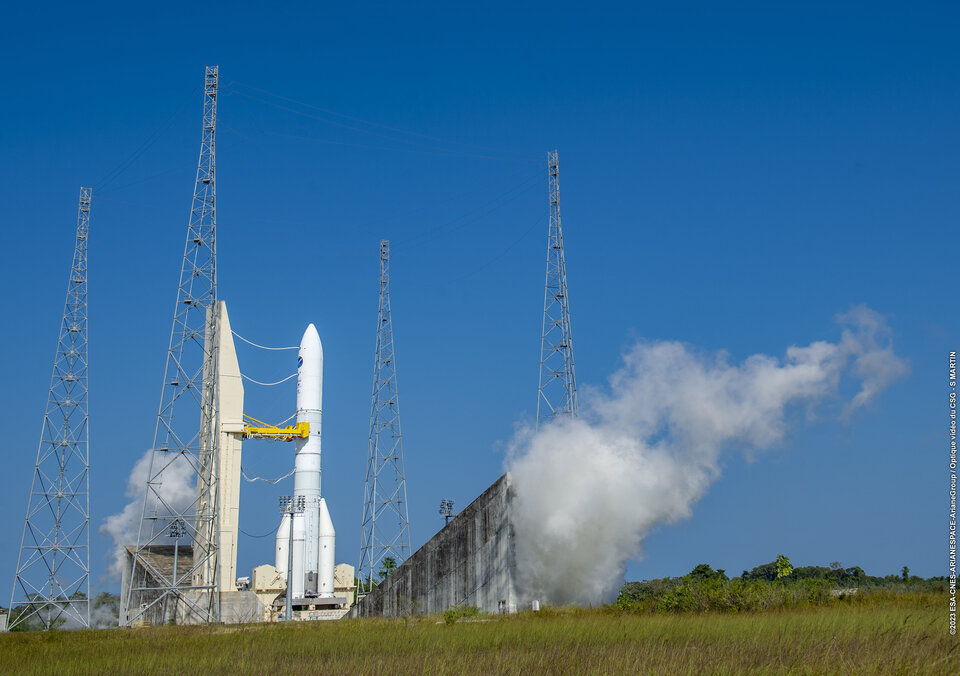
The wet rehearsal – called combined test loading, abbreviated to CTLO2.1 – is the third time the Ariane 6 ground teams have practiced a full launch countdown, after a first rehearsal on 18 July and a first ignition of the main engine on 5 September. Yesterday’s test concentrated on system robustness and how well Ariane 6 and the teams handle situations at the edge of the operational parameters. This time, the operations were performed at night to test operations in cooler ambient temperatures, while the July and September tests were run in daylight.
“The whole team performed this CTLO2.1 countdown to near perfection,” exclaims Jean-Michel Rizzi, ESA Ariane 6 launch base manager, “it was a very long operation but the dedicated teams and efforts put in achieved a complete success, bravo to everybody involved.”
Cold liquid fuel – and lots of it
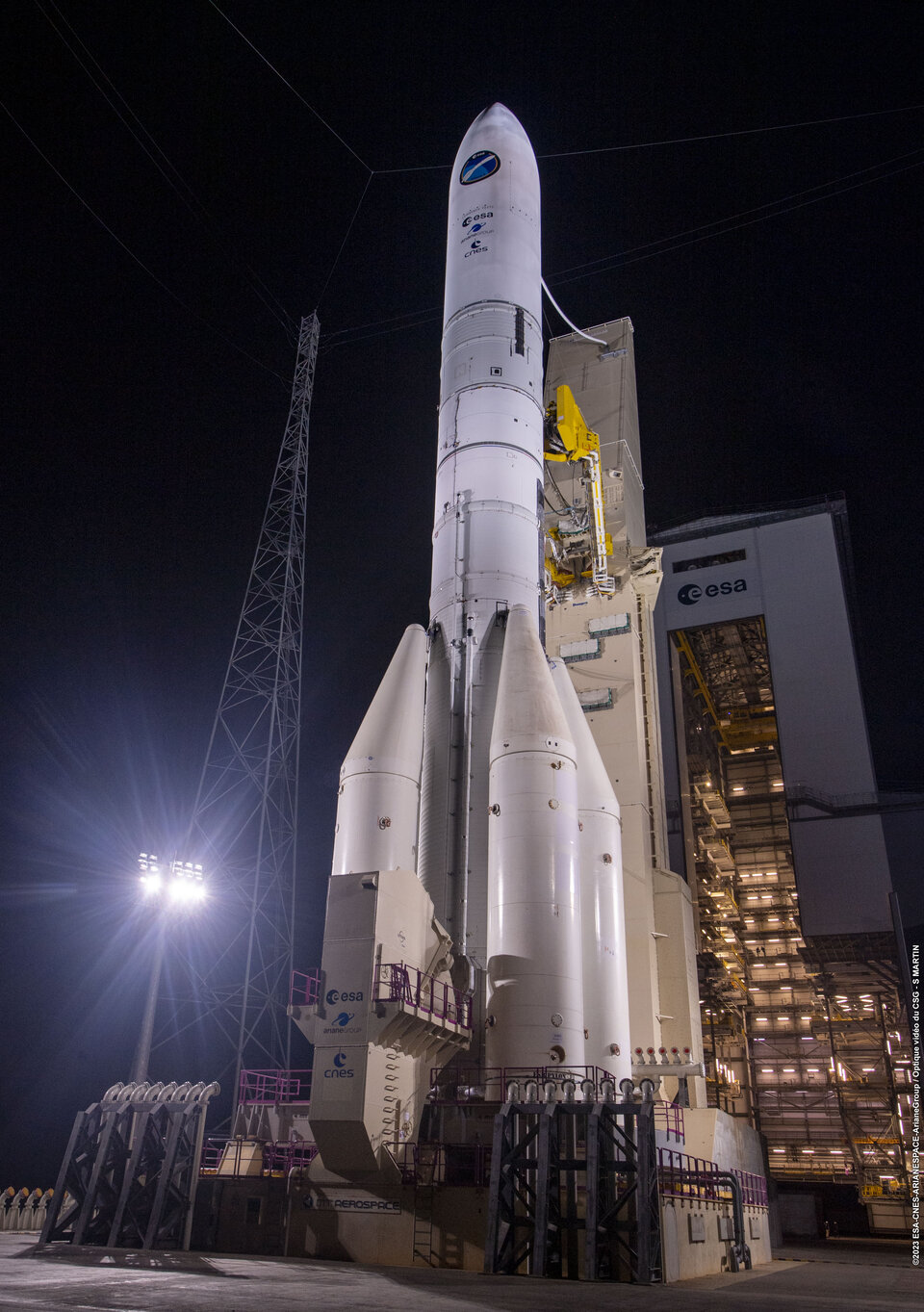
Ariane 6 uses liquid oxygen and hydrogen as its fuel to power into space. These power-dense liquids are great fuels but need to be chilled to extreme temperatures below -250°C, making them hazardous to work with. At these temperatures the liquids will instantly expand if it heats up and can cause condensation or even ice on the rocket as it cools down in the surrounding tropically humid air.
Ariane 6 tanks hold 180 tonnes of propellant, which is why fuelling and then draining operations take so long – it took over seven hours to drain the liquid hydrogen from its tanks alone. Engineers are constantly adapting flow rate and monitoring temperatures, pressure in the tanks and pipes, and the ground systems underground pipelines that extend through hundreds of meters to transport the fuel to the rocket.
The core stage of the Ariane 6 now standing on its launchpad is identical to the real thing, but it is not meant to leave Earth. The rocket boosters are inert as they use solid propellant and don’t require fuelling, but the rest is the real deal – including the Vinci upper stage that would only fire its engines once separated from the core stage in space. The fuelling of the upper stage is also included in all rehearsals.
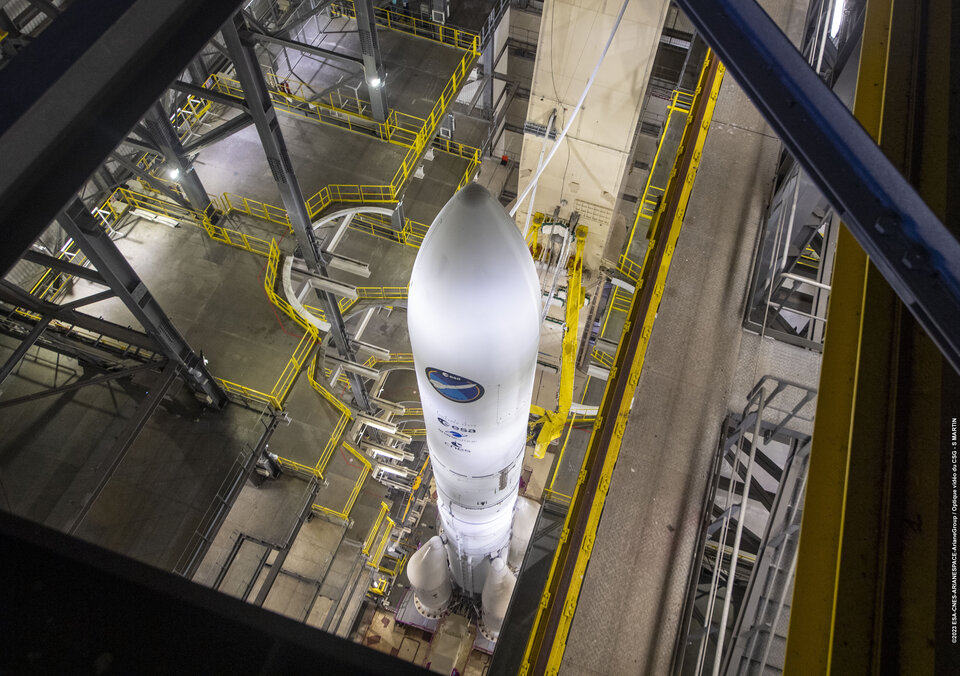
“We prepare for a launch, or in this case a rehearsal, many days in advance,” says Tony dos Santos, ESA’s Ariane 6 ground systems operations manager at Kourou, “the ground tanks where we store the liquid hydrogen and oxygen need to be replenished, the launchpad needs to be primed and prepared: it’s an all-hands operation working in shifts that is a major collective effort involving teams from ESA, CNES, Arianegroup and Arianespace based on both sides of the Atlantic, both in Les Mureaux, France, and Kourou.”
“This night-time rehearsal allowed the teams to practice loading the rocket with fuel when the temperature outside is lower – without the tropical sunlight shining on the Ariane 6 tanks the fuel inside behaves noticeably different and we need to consider and accommodate for condensation and ice formation.”
Rehearse for launch
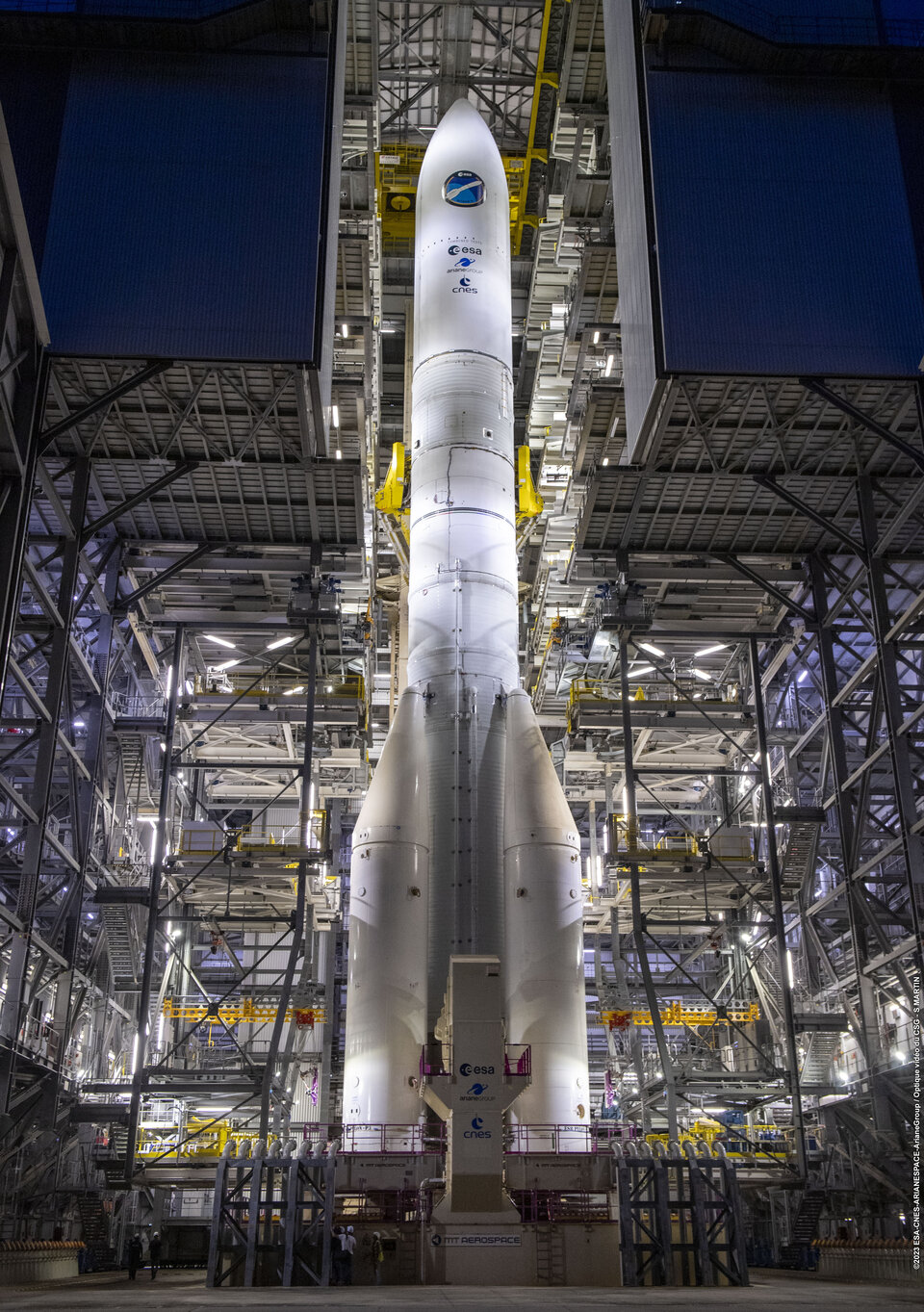
“As these operations are so delicate, and Ariane 6 is an all-new launch system, the more rehearsals we can do, the better, because we need to explore the robustness of the systems.” explains Pier Domenico Resta, ESA’s Ariane 6 launch system and engineering manager, “Through simulations of off-nominal situations the CTLO 2.1 has given the operational teams more confidence in launch countdowns and more test data for analysis and smooth operations to liftoff.”
After this successful rehearsal, the next major test will turn up the heat: a full eight-minute firing of the Ariane 6 rocket’s main engine that would normally propel the rocket and its passengers into space. For this test, scheduled before the end of November, the Ariane 6 test model will continue to stay firmly fixed to the ground.
“We are working all out to get Ariane 6 off the ground and looking forward to see it rise from the launchpad soon,” concludes Pier Domenico.
Quelle: ESA
----
Update: 25.11.2023
.
Europe's new Ariane 6 rocket aces crucial 7-minute engine burn
Quelle: SC
----
Update: 2.12.2023
.
ESA sets mid-2024 date for first Ariane 6 launch

After a successful long-duration engine test, ESA says the first Ariane 6 launch is planned for mid-2024. Credit: ESA/M. Pedoussaut
WASHINGTON — With the successful completion of a core stage hot-fire test, the European Space Agency says it now expects the first launch of the Ariane 6 to take place in the middle of 2024.
At a Nov. 30 briefing, ESA Director General Josef Aschbacher announced a launch period for the inaugural Ariane 6 flight of June 15 through July 31. A more precise launch date will be provided after qualification reviews in the spring of 2024.
The announcement comes after a Nov. 23 long-duration test firing of a model of the core stage of the Ariane 6. That test, conducted on the launch pad at Kourou, French Guiana, was intended to simulate a full burn by the core stage.
“It became pretty clear right after the test that this was going very well,” Aschbacher said, a conclusion affirmed at a meeting of an Ariane 6 task force Nov. 29, allowing ESA to set a launch date. “We are very confident that the test was a full success.”
During that test, the core stage’s Vulcain 2.1 engine was intended to fire for 470 seconds. However, the engine shut down after 426 seconds, which officials attributed to a faulty sensor and “very conservative” test thresholds intended to protect the launch pad that would not have been used on an actual launch.
“All the objectives for the test were anyway achieved,” said Toni Tolker-Nielsen, ESA’s director of space transportation. “It didn’t change the success of the test.”
The core stage test took place after a Sept. 1 test of the Ariane 6 upper stage in Germany, which confirmed its performance in a nominal flight. “We’ve got all the hot-fire tests which are needed for the qualification of the maiden flight,” said Martin Sion, chief executive of ArianeGroup, the prime contractor for the Ariane 6.
There are still some additional tests planned before the first launch. Another upper stage test is scheduled for Dec. 7 in Germany to test its performance in “degraded” conditions. A fueling test of the Ariane 6 in Kourou is scheduled for Dec. 15, which will conclude with a brief ignition of the core stage engine.
Flight hardware for the first Ariane 6 launch, called FM1, will be transported by ship from Europe to French Guiana, arriving in February. It will undergo final tests there, including a wet dress rehearsal, Sion said.
The first launch will carry several small satellites. “It’s not bringing a major payload into space,” Aschbacher said, but noted the agency wanted to still use the flight as an opportunity for smaller satellites.
If the first launch is successful, ESA and Arianespace will work towards a second launch before the end of 2024. “The target is to have a second flight by the end of the year,” said Stéphane Israël, chief executive of Arianespace. “This is a key target for us.” That second launch, he later said, would carry the CSO-3 reconnaissance satellite for the French military.
He said that Arianespace will seek to conduct “as many flights as possible” in 2025, including the first launches for its largest commercial customer, Amazon’s Project Kuiper constellation. The long-term goal is 9 to 10 Ariane 6 launches per year.
Aschbacher said the test, along with an agreement on future support for the Ariane 6 reached at the European Space Summit in Seville, Spain, Nov. 6, marked the beginning of the end of a “launcher crisis” that has temporarily deprived Europe of independent access to space. That crisis, caused by Ariane 6 delays as well as the grounding of the Vega C after a December 2022 launch failure, has required ESA and the European Commission to turn to SpaceX for launches of key science and navigation satellites.
“One should not underestimate the decisions of Seville,” he said, where ESA members agreed to provide up to 340 million euros ($370 million) a year in support for the Ariane 6, authorizing the purchase of a tranche of 27 rockets after the initial group of 15. The agreement also included support at lower levels for Vega C. “To have this access to space guaranteed now throughout the decade, both for the Ariane 6 and the Vega C launchers, is fundamental.”
“It is really fundamental that we regain our foothold on the launcher landscape,” he said at the end of the briefing. “But, of course, we have yet to perform.”
Quelle: SN
----
Update: 21.12.2023
.
Ariane 6 schedule not affected by aborted upper stage test

WASHINGTON — The European Space Agency says the first launch of the Ariane 6 remains on track for the middle of 2024 despite an aborted test of the rocket’s upper stage.
In a Dec. 19 statement, ESA said it successfully completed a test of an Ariane 6 prototype called combined test loading, or CTLO3, at the spaceport in Kourou, French Guiana, Dec. 15. In the test, the rocket’s core and upper stages were loaded with propellants and went through a practice countdown that concluded with a four-second firing of the core stage’s Vulcain 2.1 engine.
CTLO3 also demonstrated what ESA called “extreme ignition conditions and degraded modes of liftoff” as well as abort modes that required unloading propellants from the rocket with “very limited control resources.”
“The rehearsal was very well executed, and the countdown ran exactly as planned,” ESA said in a Dec. 19 statement, calling the test a complete success. “The launch operations for Ariane 6 are mastered, we are ready to go.”
However, a test of the upper stage eight days earlier was not a complete success. A hot-fire test of the upper stage, called HFT-4, at a facility in Lampoldshausen, Germany, was aborted two minutes into the test when “some parameters had gone beyond predetermined thresholds,” ESA said in a statement.
The HFT-4 test was intended to test how the upper stage would perform in “extreme and unexpected conditions” rather than those expected in a normal flight. ESA said the cause of the abort is under investigation, with an update expected in mid-January.
ESA first revealed the problem with HFT-4 at a Dec. 14 briefing after a meeting of the ESA Council. “There are no signs that it will delay the announced inaugural flight date,” said Toni Tolker-Nielsen, ESA director of space transportation. ESA announced Nov. 30 a launch period of between June 15 and July 31 for the first Ariane 6.
ESA reiterated that in its statement. “We are confident that these investigations will not impact the schedule to Ariane 6 inaugural flight,” it said of the HFT-4 abort.
Some tests of the launch system will continue into early 2024. ESA said tests are planned at the end of January of the disconnection system for umbilicals at the launch pad for fueling the rocket. The flight hardware for the first Ariane 6 launch is scheduled to arrive in Kourou in mid-February.
Quelle: SN
----
Update: 22.12.2023
.
Green hydrogen for Ariane 6 and more

Hyguane: green hydrogen for Ariane 6, Europe's Spaceport and more
Ariane 6 uses liquid hydrogen and liquid oxygen as fuel for its main and upper stages. Hydrogen in its gaseous form (H2) is rarely found on Earth, and so is currently produced in French Guiana from steam reforming of methanol (CH3OH).
Other processes are far more sustainable and so ESA and France’s space agency CNES wish to switch to solar-powered electrolysis of water which can reduce by five the amount of carbon dioxide emitted for hydrogen production.
ESA and CNES are determined to reduce the footprint of rocket launches and ground operations at Europe’s Spaceport in French Guiana, and are aiming to deliver low-carbon hydrogen generated by solar-powered electrolysis of water by 2026.
Project Hyguane – a portmanteau of the French words for hydrogen, French Guiana and the local Iguanas – is a €40.5M investment in a solar farm and distribution systems and is being designed to be allowed to easily expand in the future.
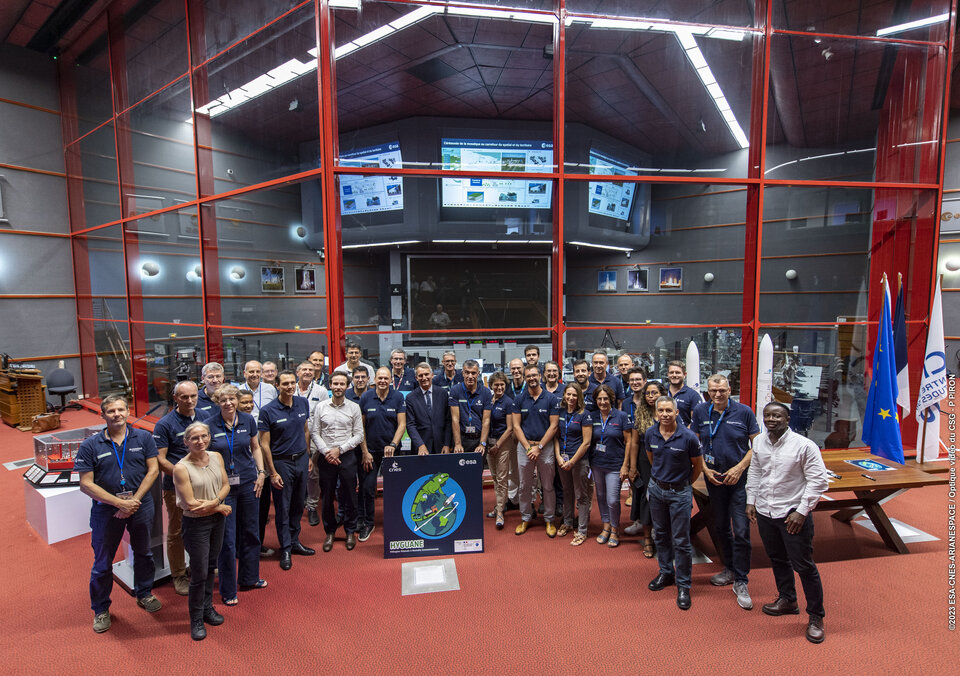
The Hyguane facility could save over 3000 tonnes of equivalent carbon dioxide emissions a year when operational, while supplying up to 12% of Ariane 6 needs based on nine launches per year.
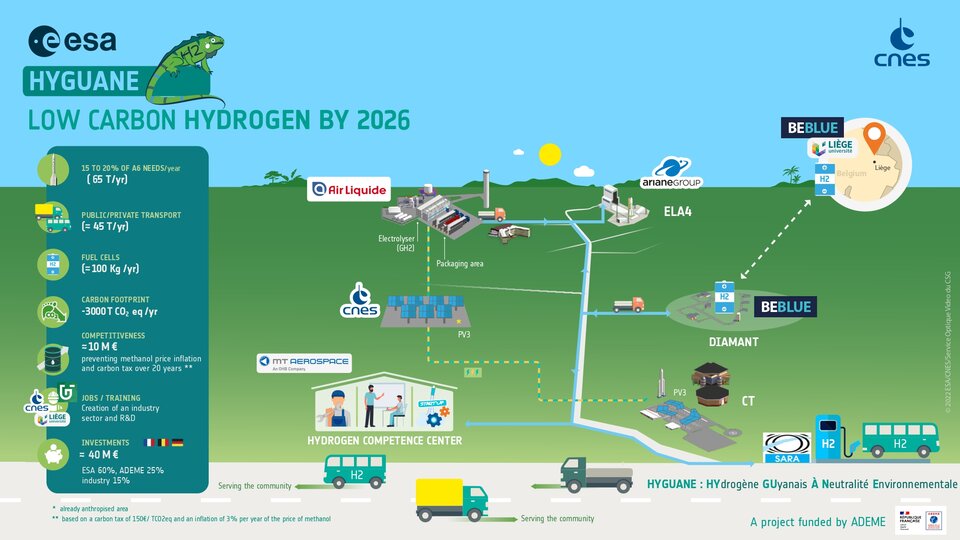
The project does not stop at the space sector, by supplying hydrogen fuel cells it will allow low-carbon vehicles and hydrogen electricity generators to operate in French Guiana. The project will ease the transition to hydrogen vehicles and demonstrate that fuel cells can replace diesel-engine generators.
A hydrogen refuelling station designed and operated by SARA and a Hydrogen Competence Centre operated by MT-Aerospace are key factors in developing low-carbon transport in French Guiana as they allow for vehicle fuelling and maintenance.
The project is a large contribution to CNES and ESA’s sustainability efforts to make 90% of Europe’s Spaceport run on renewable energy by 2030.
Teddy Peponnet, head of the project for ESA, said “this novel facility will be a shining example of carbon-free production of hydrogen when it opens and we aim to set an example for a more sustainable future.”
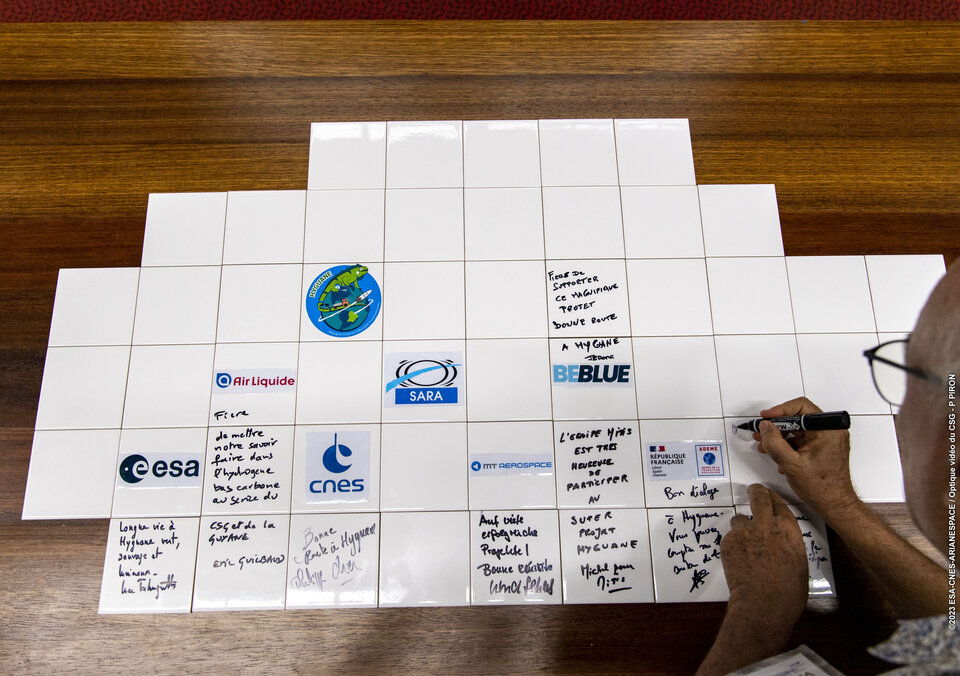
After three years of studies, the project started on 13 December with the signing of the consortium agreement between the parties involved: four companies – Air Liquide, SARA, MT-Aerospace and BEBLUE; three universities – Université de Guyane, Université de Liège, Université Libre de Bruxelles and two institutions – ESA and CNES. ADEME, the french agency in charge of ecology transition is as well part of the project, is financially supporting Hyguane with €10M.
Planned for completion in 2026, the project could be extended to double the production of hydrogen and supply additional hydrogen vehicles (such as coaches, buses, and trucks) and hydrogen electricity generators.
Teddy Peponnet adds “Green hydrogen is ready to fly! The technical revolution is on its way.”
Quelle: ESA


